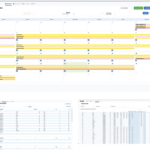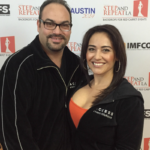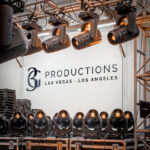It started when they were children. The three Suehle brothers were those kids at your grade school assembly who were in the back fiddling with projectors and lights, trying to make something unique happen. Enthralled with the production aspects of shows, Andy, Joe and John first worked on events at schools and churches. Their obsession became their profession. John, the eldest, got a Ph.D. in electrical engineering (yep, he’s Dr. John). Joe, in the middle, got a degree in mechanical engineering and an MBA. Andy, with a degree in mathematics, became the marketer and salesman of the trio. PLSN spoke to Joe for this article.
Though they’d been doing one-offs and freelance projects since those school days, in 1996, a light bulb went on, so to speak. As Suehle recalls, “We said, ‘We ought to pull all this stuff together, incorporate and see what we can do.’ We did, and the company, Advanced Entertainment Technologies, Inc., was born. I became the president, John the vice president and chief technology officer, and Andy the vice president for marketing, sales and client relations. We had bought some surplus medical lasers and converted them for light show use. In those days, most startups did it the same way. They got castoff lasers from various industries, tinkered with them and created projectors for laser light shows. They’re very powerful and used for cutting and burning. We had to prove to the FDA that what we’d done was safe and wouldn’t harm people’s eyes. Now we’re one of the few companies legally certified to manufacture audience-scanning laser projectors.”
Looking back, Suehle notes that “our first really big break was getting picked to do the New York City millennium in 1999, a huge, big-budget show that enabled us to take the next step in our company’s development.”
 In 2000, the company acquired the assets of Image Engineering Corp. and started doing business as Image Engineering, while still retaining Advanced Engineering Technologies as the legal name of its business. As the Suehles’ company continued to expand, Image Engineering soon attracting professional-level clients including Baltimore’s Ravens and Orioles sports teams.
In 2000, the company acquired the assets of Image Engineering Corp. and started doing business as Image Engineering, while still retaining Advanced Engineering Technologies as the legal name of its business. As the Suehles’ company continued to expand, Image Engineering soon attracting professional-level clients including Baltimore’s Ravens and Orioles sports teams.
“As you do shows and do them well, people talk, and you get more calls for bids,” Suehle says, noting the company’s work with more geographically distant clients as well, such as the NFL’s San Francisco 49ers, Seattle Seahawks and NHL’s Los Angeles Kings.
With each year, the shows and the exposure got bigger. The company, still formally known as Advanced Entertainment Technologies but doing business as Image Engineering, now has 20 full-time employees in its 22,000 square-foot headquarters, a 9,000 square-foot warehouse, and a nationwide network of expert freelancers.
Suehle attributes the company’s success to its strong engineering methodology. “It’s why ‘Engineering’ is in the name,” he points out. “Our engineers are schooled in ways to analyze problems, look for a solution, find alternatives, test those alternatives, disqualify some, and distill down to the best possible design to fit the customer’s need. In the high-profile productions we’ve done (e.g., the Brooklyn Bridge, the Washington Monument, the White House), we had to be very exacting, very clear on what we would deliver. Dealing with someone like the National Park Service or the Secret Service, they need to know that you’ve been very methodical plan and done things in a very prescribed, meticulous way. Our engineering experience reassures our clients that they’ll get exactly what they need. And besides, if not, the Secret Service is allowed to shoot you!”
From the White House to the Power Plant

Recent events have raised questions about the Secret Service’s attention to detail, but Suehle notes meticulous precautions. “Every year, the President invites a number of families to the White House for Halloween and hands out candy. It’s a huge production, with the residence all lit up and festooned with smoke and fog effects. It requires a lot of coordination with the staff and the Secret Service. You can imagine how rigorous they are about protocols and schedules and equipment lists. Weeks in advance, we submitted documents for background checks. The day of the event, before we even got near the White House, the Secret Service had us take our truck to a distant location, where they x-rayed it. Then the agents escorted our truck to one of the gates of the White House. Out came the dogs, which sniffed everything while the agents stood by with machine guns. We had to pass through two more gates, after which we were just steps away from the back door the President uses when he boards his helicopter. That was the area we worked in to set everything up. We even got to watch the chopper come in once, pick up the President and take off.”
For the Power Plant Holiday Light Spectacular in Baltimore’s Inner Harbor area, inaugurated in 2011, Image Engineering transforms the Power Plant, one of the city’s oldest, most iconic buildings, into a 32,000-square-foot canvas of 3D video motion graphics, multicolored laser effects and choreographed pyrotechnics. “We approach something of this scale in layers,” explains Suehle. “The most crucial layer is the video map of the building, with laser projections on top of that coordinated to the video image. Next come aerial laser beams, then a layer of pyrotechnic effects synced to the soundtrack. The last layer, a ‘4D’ effect, is faux snow actually blowing around the concourse so people feel immersed in the show. It has to run flawlessly 75 times between mid-November and New Year’s Eve.” The huge light show made national news and has become a tradition for the holidays, drawing 40,000 people.
Way Cool
In February and March 2013, the Kennedy Center in Washington, D.C., hosted the Scandinavian festival called Nordic Cool, commissioning Danish lighting designer Jesper Kongshaug to design a nightly display on all four sides of the building. To help realize his vision, he chose Image Engineering, who suggested imitating one of the world’s original light shows, the aurora borealis or Northern Lights. “We used technology to make it look like an organic part of Mother Nature,” recounts Suehle. “We built a bubbled glass rotator that turned at random speeds so that subtle movements in the glass, coupled with the lasers, created unpredictable, non-repeating patterns in a diffuse light effect called lumia. It looked just like the aurora borealis viewed from a Nordic forest.”
Key to the project’s success was Image Engineering’s inventory of high-powered laser projectors. Ultimately, eight 20-watt and two 50-watt full-color laser projectors were used around the 2,500-linear-foot perimeter of the building. The design required the projection systems to synchronize with a custom soundtrack, and the display had to operate in all types of winter weather for 32 consecutive evenings. It made the front page of the Washington Post and won an award from the International Laser Display Association (ILDA).
In another example of its creativity, Image Engineering provides laser effects for the television show America’s Got Talent. In one instance, says Suehle, “they wanted a diode bar grid effect like one they had seen at a music festival in the U.K.. Our engineers designed and built the system in five weeks, It used lasers in an entirely new way, with 360 individual lasers all pointed down at the stage behind the piano player, creating a ‘curtain of lasers’ effect. Each one was addressed, so the grandMA operator could run low-res video through the array and get amazing undulating patterns just by turning diodes on and off.”
Laser Focus on Safety
Of the many challenges of live TV, Suehle thinks “the biggest is safety. We look at safety extremely sternly. We have laser safety officers and regulatory compliance in place. You can’t afford to have something go wrong, because it would be bad not only for the production but for the whole industry. People could start to view lasers as unsafe and avoid using them. On TV, you often only have the length of a commercial break to get set. You have to amp up all the precautions you take normally and get it exactly right. If you’re not sure, you don’t do the effect. In our business, we all take it very seriously. I’m very proud of the work I see my competitors doing, because it’s done safely and professionally and right. When they do a great job with lasers, it makes my business stronger, too.”
Game Changers

One niche that Image Engineering has practically sired (or at least foster-parented) is the player introduction extravaganza that precedes NFL games. “When the players run out from the locker room, there’s fire and smoke and lights and it’s a big production. We certainly didn’t originate that, but we had a large role in setting a high bar for what it looks like today. We work with eight NFL teams to design, build and produce unique grand entrances for each one.”
Speaking of game-changing, when Image Engineering noticed that LDs are more comfortable with lasers if they have personal control of them, the company created a hardware/software solution called Beam Composer (See “Product Spotlight,” PLSN, Nov. 2014).Explains Suehle, “Before, you’d bring in a laser light show company and a laser programmer. The lighting designer tells the programmer what effects are needed for a particular moment in the show. The programmer inputs it so it can be pulled up on cue at the console by the lighting designer. Beam Composer eliminates the programmer step. The designer creates the effect from scratch while programming the rest of the lights. Accessing it, programming it or making it change colors or bounce can now be done from the console, like any moving light fixture. The whole production looks tighter, like everything is intended. It’s perfect for running lasers in a tour environment.”
This Little Light
The company’s audience-scanning laser could change the way the industry looks at lasers. “We came up with a new way of doing it that will allow them to be brighter and look more like laser beams,” Suehle says. “There are only three things you can do to a laser beam to make it safe: You can drop the power, widen the beam or make the beam cross the eye very quickly. Everybody else has been using the first two methods, but they diminish that classic laser look. It gets diffused, which destroys the beauty of the beam. So we created projectors in our Light Vector Series that make the beam scan really fast. The latest, called the CS10, is a white balanced 10W RGB laser projector (100 percent diode) specifically for audience scanning effects. It’s fully DMX controllable, eliminates the need for a separate laser operator or software, and seamlessly integrates into a production’s lighting rig. It’s modeled after a typical moving light, so it’s simple to use, yet extremely versatile. The high-speed synchronous scanning engine allows the effect to be tighter and brighter, while still safe and FDA-compliant. Our 25- and 50-watt lasers, the CS10’s big brothers, have been out with Jay-Z, Rihanna and Guns N’ Roses, to name a few,” Suehle says, noting their introduction in 2011. “They’re very reliable workhorses, and we’re improving them even more as touring production managers ask for brighter, more colorful lasers in smaller boxes that fit better in the truss and take up less space and weight in the trucks. We’re also exploring ways to make lasers look less traditional. In a standard light show, the lasers emanate from an aperture with a scan angle of 40° to 60° horizontally and vertically in a pyramid cone shape. That’s limiting. Since the technology has gotten a lot less expensive and you don’t need water and three-phase electricity to run them anymore, the field is ripe for innovation. We’re looking really hard at how we can innovate laser displays, pyrotechnics, integration, video mapping, everything you see in a big touring production. We want to up the ante and make them even more spectacular.”
As Suehle sees it, the industry is doing well. “Musical artists nowadays are doing more touring and big productions. The lasers, pyro and other special effects make the shows more compelling. That bodes well for our business and makes it incumbent on all of us to be really creative and safe. You can have lots of equipment, millions of dollars in assets, all that stuff. But Image Engineering’s biggest asset is the client. We’ve developed and sharpened our ability to really listen to them, understand their needs and engineer solutions. If it requires a special approach for them that must be thought through very carefully and executed extremely exactly, that’s our specialty. We honor our clients. They have helped us grow and have been there for us. We feel fortunate to do so many different things for such great clients.”


